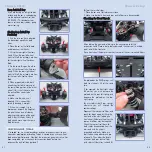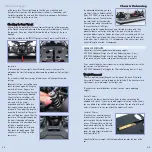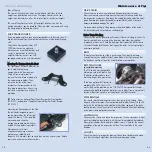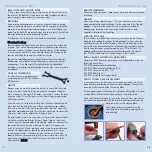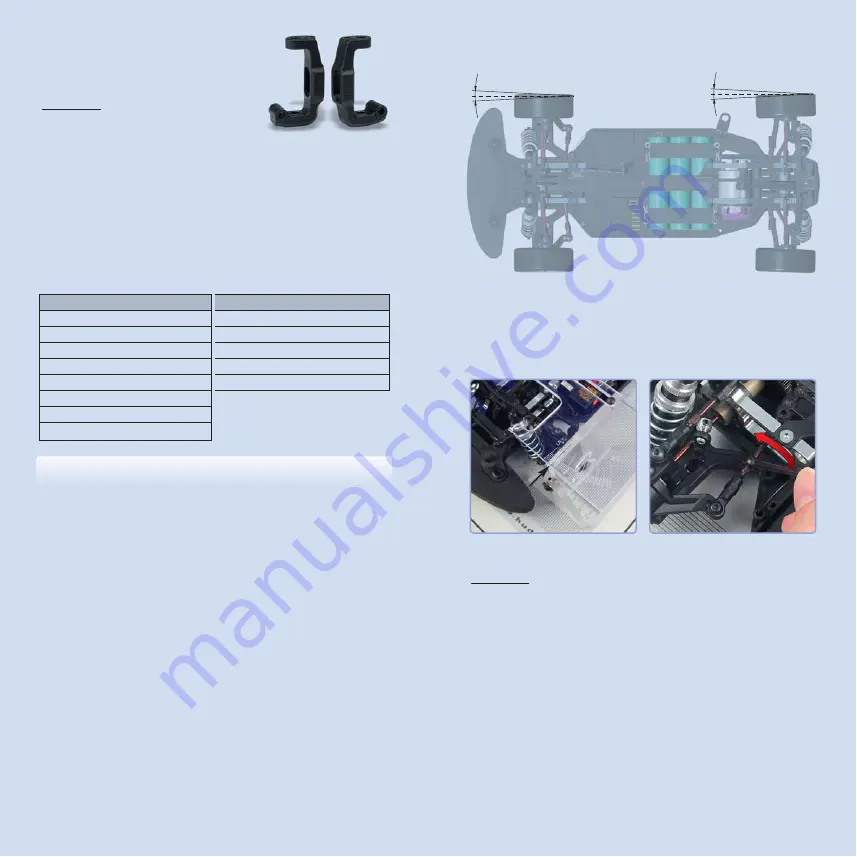
A
Ad
djju
ussttiin
ng
g F
Frro
on
ntt T
To
oe
e--IIn
n // T
To
oe
e--O
Ou
utt
Front toe-in is adjusted with the steering rods that connect the servo saver
to the steering blocks. Making the steering rods longer will create more
toe-in, while making them shorter will create more toe-out. Be sure to
adjust both steering rods in equal amounts to reach the desired toe angle.
Measure front toe-in using the Hudy Set-Up System.
Initial Setting:
Front toe-in: 0° (front wheels are parallel)
A
Ad
djju
ussttiin
ng
g R
Re
ea
arr T
To
oe
e--IIn
n
Rear toe-in is adjusted by adding or removing clips between the bulkheads
and the rear lower suspension pin holders (at the BACK of the bulkheads).
This angles the rear lower arms forward or backward. The initial rear toe-
in setting is 3°.
To change rear toe-in, loosen the screws that hold the rear lower suspension
pin holders (at the BACK of the bulkheads) to the bulkheads. Then, slide a
clip onto the screw, between the holder and the bulkhead. The thicker the
clip, the more rear toe-in. Tighten the screw to secure the pin holders.
Make sure you add the same thickness of clip to both left and right sides.
The following table indicates the effect of adding rear toe-in clips.
Chassis Setup
The C-hub blocks that hold the
steering blocks have a specific
amount of caster molded into them.
Initial Setting:
Front caster: 3
°
, left and right
Note: The anti-dive setting impacts the caster
setting. To get the true caster setting, add the value of caster block to the
front anti-dive value. For example, if you have 3° caster block and set 3°
anti-dive, the overall caster setting is 6° caster.
C
Ch
ha
an
ng
giin
ng
g C
Ca
asstte
err
To change the caster angle, you must change the front C-hub blocks to
those with a different caster angle. When changing the C-hubs, you must
use left and right C-hubs that have the same caster angle.
XRAY offers several different C-hub blocks of different caster angles and
different compounds:
TOE-IN & TOE-OUT
Toe-in is the angle of the wheels as looked at from directly above the car.
When the wheels are parallel the toe-in is 0°. When the front of the wheels
are pointing away from each other, that is called toe-out. When the front of
the wheels are pointing in towards each other, that is called toe-in.
Toe-in is used to stabilize the car, but at the cost of traction. If the car is
oversteering (the rear end loses traction before the front end) extra front toe-
in may reduce oversteer, but it also decreases steering. If the car is
understeering (the front end loses traction before the rear end) extra front
toe-our (or extra rear toe-in) may help, but this makes on-power cornering
more difficult.
Front toe-in makes the car easier to drive by improving stability during
acceleration, and gives a slight increase in steering exiting corners. Front toe-
out increases steering when entering corners, but makes the car slightly more
difficult to drive.
Perform these initial steps:
1. Remove wheels.
2. Put the car on the Hudy Set-Up System.
3. Turn the radio and receiver on, and turn the wheels left and right to let the
steering set into the neutral position.
4. Press down the suspension of the car a few times to let the suspension settle.
Chassis Setup
25
26
TOE OUT
TOE IN
TOE OUT
TOE IN
FRONT C-HUB BLOCKS,
COMPOSITE
3° RIGHT
SOFT
# 302281
3° LEFT
SOFT
# 302283
6° RIGHT
SOFT
# 302285
6° LEFT
SOFT
# 302287
3° RIGHT
MEDIUM
# 302282
3° LEFT
MEDIUM
# 302284
6° RIGHT
MEDIUM
# 302286
6° LEFT
MEDIUM
# 302288
FRONT C-HUB BLOCKS,
ALU
0° RIGHT+LEFT HARD
# 302275
3° RIGHT
HARD
# 302276
3° LEFT
HARD
# 302277
6° RIGHT
HARD
# 302278
6° LEFT
HARD
# 302279
Summary of Contents for T1R Raycer
Page 1: ......

















